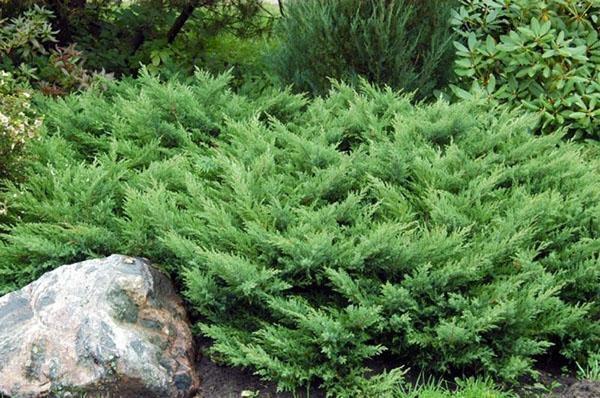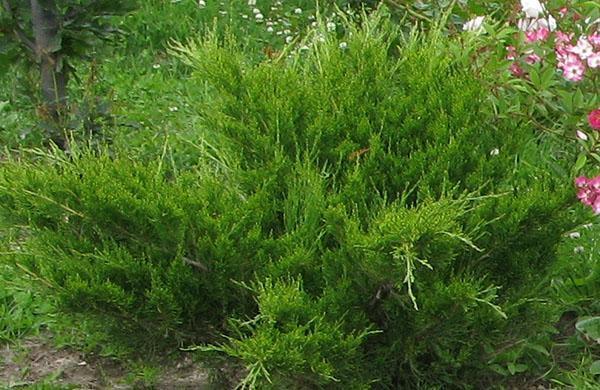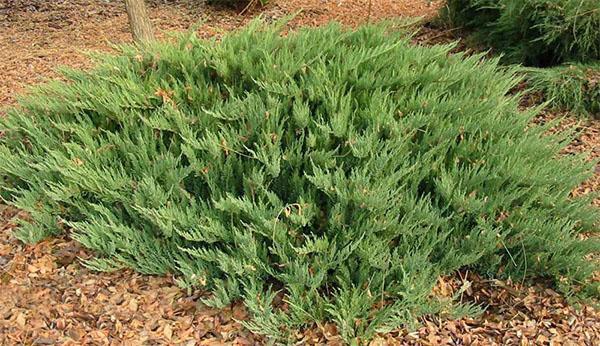Features of the cultivation and reproduction of Cossack juniper
 Coniferous shrubs are very popular in modern landscape design. Juniper Cossack is the most common and unpretentious representative of its family. This plant is used not only in home gardens and parks, but also at home.
Coniferous shrubs are very popular in modern landscape design. Juniper Cossack is the most common and unpretentious representative of its family. This plant is used not only in home gardens and parks, but also at home.
These creeping coniferous shrubs of the Cypress family attract many for their decorative qualities, as well as resistance to drought, frost and polluted air. Its natural habitat is Asia Minor, Southeast Asia, the Caucasus, the Urals, Siberia and Primorye, South and Central Europe.
Description of the plant

The Cossack juniper is described as follows:
- Most often, the plant is a woody bush, reaching a height of 1-1.5 meters, capable of growing and forming thickets. Less commonly, plants of this species are referred to as low trees with curved trunks.

- In young plants and on branches protected from direct sunlight, needles are needle-shaped, erect, pointed, reaching a length of 4-6 mm. In adult representatives, leaf-like organs are scaly, resembling shingles in their laying.
- When rubbed, shoots have a characteristic, pungent smell due to the content of special essential oils, which are poisonous.
- Male and female flowers are found on different plants of this species. Cones are small (up to 7 mm in diameter) balls of black color with a brownish-gray tint. Each of them can contain up to 4 seeds.
Cossack juniper essential oil contains poisonous substances such as sabinol, sabinene and other terpene derivatives. If the family has small children, then you should postpone the cultivation of this plant.
Planting and leaving
 First of all, you should decide on a permanent landing site. This type of juniper is light-loving, and if planted in the shade, it can lose its decorative properties. In addition, a distance of up to half a meter must be maintained between plants.
First of all, you should decide on a permanent landing site. This type of juniper is light-loving, and if planted in the shade, it can lose its decorative properties. In addition, a distance of up to half a meter must be maintained between plants.
Planting and caring for Cossack juniper has a number of features:
- A plant with an open root system can be planted in the ground only in mid-spring or early autumn, when stable moderately humid weather is observed. Moreover, such a root system should be pre-treated with stimulants to improve root formation.
- Large plants should be planted so that the transition zone from the root to the stem protrudes 5-10 cm above the edge of the planting pit. And in immature plants, it should be located at ground level.
- It is recommended to saturate seedlings from containers with water before planting. For this, a clod of earth should be held in a pan with water for 2 hours.
- The depth of the planting pit should be proportional to the soil of the container plant and the size of the already developed roots. Usually the pit for planting the Cossack juniper should be 2-3 times larger than the clod of earth.
- At the base of the pit, there should be a drainage layer (up to 20 cm wide) - sand combined with broken brick. And the root system is sprinkled with a special soil mixture. It usually consists of peat, turf and sand (2: 1: 1).
- The planted plant is immediately watered abundantly and the soil is covered with mulch (peat, pine bark, compost) to protect and improve its properties. Usually 5-8 cm of mulch is sufficient.

- Juniper should be watered only in dry summers, but no more than 3 times during the season. For one adult plant, 10 to 30 liters of water is enough. And spraying should be done every 7 days, but only when the sun has already set.
- In the second half of spring, the plant can be fertilized. Nitroammofosk and Kemira-wagon are good for these purposes. Young plantings need shallow loosening, which increases air access to the soil.
When buying, you should carefully examine the needles of the plant. At the slightest sign of illness, it is better to refuse to purchase this instance.
Pruning, shaping and propagation
 Pruning Cossack juniper should be done carefully and deliberately. As a rule, he does not need such manipulations, but with the help of garden shears for cutting bushes, damaged, infected and dry branches must be removed in a timely manner. Pruning is used when they want to change the direction of growth of branches, to stop growth or to give a special decorative shape.
Pruning Cossack juniper should be done carefully and deliberately. As a rule, he does not need such manipulations, but with the help of garden shears for cutting bushes, damaged, infected and dry branches must be removed in a timely manner. Pruning is used when they want to change the direction of growth of branches, to stop growth or to give a special decorative shape.
The formation of the Cossack juniper is carried out in spring and autumn, while the average daily air temperature should be + 4 ° С. During the year, the Cossack juniper can grow up to 10 cm, and the permissible pruning rate in this case should not exceed 2 cm. The plant, as a rule, does not need to cover up the wounds. If severe damage is present, then the cut can be treated with resin or sprayed with Epin.
Plucking the tips of new shoots is a safer and less harmful way of forming a crown than cutting. This way you can strengthen the branching and make the bush more lush.
 There are 4 ways to breed Cossack juniper:
There are 4 ways to breed Cossack juniper:
- Seeds are a rather complicated method that is rarely used due to forced stratification. The seeds of the plant are kept for a long time in special conditions to stimulate germination.
- Cutting - This method is best used in April or August. It should be cloudy for several days so that the bright sun does not harm the cuttings and the original plant.
- Layers - This method is great for creeping plant forms with young shoots. Individual branches are fixed on the ground with wooden pins, and the soil around is piled up and watered from time to time.
- Vaccinations - this method does not always justify itself. An elite variety of a plant is grafted onto an ordinary one, wrapped with foil and await engraftment.
 How to propagate Cossack juniper is a personal decision of a specialist or an amateur gardener. However, it is important to do everything so as not to damage the original plant.
How to propagate Cossack juniper is a personal decision of a specialist or an amateur gardener. However, it is important to do everything so as not to damage the original plant.
Landscape design
 The plant is actively used when organizing relief on different types of slopes, for decorating rocky hills, lawns, hedges... It can be used as a separate decorative element (tapeworm) or in group plantings that act as a background or lawn framing.
The plant is actively used when organizing relief on different types of slopes, for decorating rocky hills, lawns, hedges... It can be used as a separate decorative element (tapeworm) or in group plantings that act as a background or lawn framing.
 As you can see in the below juniper photo, Cossack juniper in landscape design goes well with brighter perennial crops. At the same time, it should be borne in mind that these conifers are not combined with lush vegetation with large inflorescences.
As you can see in the below juniper photo, Cossack juniper in landscape design goes well with brighter perennial crops. At the same time, it should be borne in mind that these conifers are not combined with lush vegetation with large inflorescences.
 Quite often, Cossack juniper is used in the English (landscape) style of landscape design. As a rule, large varieties of this plant are chosen with the correct crown shape and restrained color of the needles. Junipers in an English garden are meant to complement the landscape, not to focus on themselves.
Quite often, Cossack juniper is used in the English (landscape) style of landscape design. As a rule, large varieties of this plant are chosen with the correct crown shape and restrained color of the needles. Junipers in an English garden are meant to complement the landscape, not to focus on themselves.
 The austere varieties of this plant are also popular in Japanese-style compositions. They contrast perfectly against the background of bright colors and colorful details of the oriental garden.In the design of such compositions, designers advise planting juniper plants near ordinary heather, which can be of all kinds of shades, as well as next to rocky hills.
The austere varieties of this plant are also popular in Japanese-style compositions. They contrast perfectly against the background of bright colors and colorful details of the oriental garden.In the design of such compositions, designers advise planting juniper plants near ordinary heather, which can be of all kinds of shades, as well as next to rocky hills.
 If you plant this plant skillfully and with taste, as well as properly care for it, then it will be able to deliver aesthetic pleasure for more than one year.
If you plant this plant skillfully and with taste, as well as properly care for it, then it will be able to deliver aesthetic pleasure for more than one year.